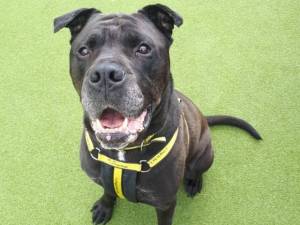Mastiff Dog Breed Information
- AKA:English Mastiff
- Size:Giant
- Ease of Training:Low/Medium
- Grooming:Low
- Shedding:Medium
- Exercise Needed:Daily walks
- Energy Level:Low
- Protection:High, guard dog
- Good with Children:Yes, when brought up with them
- Health Clearances:OFA, CERF, vWD
- Weight:175-190 lbs
- Height:Male: 30; Female: 27.5 inches
- Coat Colour:Fawn, apricot, or brindle, all with dark muzzle, ears and nose
Mastiff Coat
The Mastiff is a double coat breed. The outer coat is short, coarse, and straight. The under coat is dense and fits closely to the body. The color of the coat comes in apricot, fawn, or brindle. The nose, muzzle, and ears are black. This breed is an average shedder.
Mastiff Character
A massive, muscular, and powerful dog, the Mastiff is one of the heaviest of breeds. Males are capable of exceeding 200 pounds. They have an imposing and dominant demeanor. Mastiffs are fearless, alert, and extremely courageous. Often referred to as the Gentle Giant, they are a combination of dignity and grandeur.
Mastiff Temperament
The Mastiff is a watchful, reliable, and intelligent breed. They are exceedingly loyal and deeply devoted to their family. This breed thrives on human companionship and affection and does not do well if left alone for extended periods of time. The Mastiff does best in a home with older considerate children. They do not do well with other household pets they have not been raised with. This breed is naturally protective and is extremely possessive of their family and home. The Mastiff is not recommended for the novice, inexperienced, or passive owner.
Mastiff Care
The Mastiff requires minimal grooming. Occasional brushing with a firm bristle brush will suffice. Bathing or dry shampooing should be done when necessary. The Mastiff is prone to hip and elbow dysplasia, bloat, ectropion, PRA, cardiomyopathy, and gastric torsion. They also have a tendency to drool and snore.
Mastiff Activity
The Mastiff is slow moving and is inclined to be rather lazy. Daily securely leashed walks or a play session in a safely fenced small yard are highly recommended to keep them happy and fit. They will do okay in an apartment or condominium dwelling provided they are given stimulation, attention, and sufficient exercise.
Mastiff Health and Life Expectancy
As with many larger dog breeds, the Mastiff has a relatively low life expectancy compared to some breed, and lives for around 5-10 years. There are a number of health problems to look out for with this breed, and this includes: luxating patella, strokes, epilepsy, spinal problems, eye problems, thyroid disorders, OCD, HOD, HD and elbow dysplasia, heart defects, bloat, kidney problems, and sensitivity to drugs and chemicals. They can also suffer heatstroke in very hot conditions. The parents of the Mastiff should have OFA and CERF certificates.
Latest Mastiff Dogs for adoption

Gunner - male Mastiff Cross
- Telford
Adoption fee: Please check with the rescue
Gunner has a special knack for making every day brighter. His love for treats and toys knows no bounds, and he's always ready for a game of fetch or a tasty snack. Despite his age, Gunner is still bri

Bingo - male Mastiff Cross
- Bridgend
Adoption fee: Please check with the rescue
Bingo is a gorgeous one year old collie cross mastiff. He will need multiple visits to the centre and a few home visits to ensure he builds a bond with his new adopters. It doesn’t take long for

Gary - male Mastiff Cross
- Darlington
Adoption fee: Please check with the rescue
Gary's one true love is food. This has helped immensely with the training that he has been receiving at the centre (alongside his clever brain) and he really enjoys learning new things. He can be a li

Obie - male Mastiff Cross
- Evesham
Adoption fee: Please check with the rescue
Obie is a Crossbreed who is 1 year old and has experienced a lot of change in his short life. A big puppy, he will need understanding owners who are not phased by his bounciness and who are happy to c

Holly - female Mastiff Cross
- Loughborough
Adoption fee: Please check with the rescue
3 year old Holly is house trained and has the potential to be left 3-4 hours once settled in her new home, she would make an excellent companion if you were working from home also. Holly can be a litt